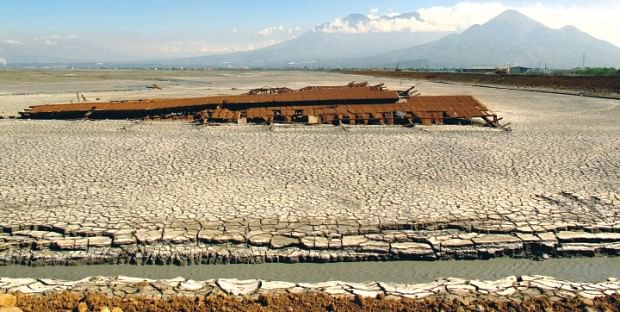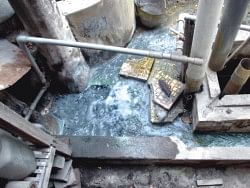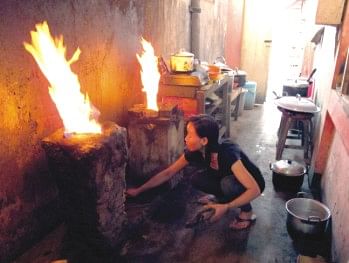|
International
 |
The roof of a factory reminds of the formerly biggest employer in the region. Photo: Valerie Sticher |
A Muddy Affair
Independent research suggests that the drilling activities of an Indonesian oil and gas exploration company triggered the world's largest mud volcano. But the Indonesian Supreme Court has cleared the company of blame. Years after being displaced, many victims are still waiting for the promised compensation.
Valerie Sticher
"There's my house,” Soli points his finger to the middle of a mud field. The only thing that remains visible from Soli's village is the top of its mosque. His village was among the first ones to be swallowed by the mud in 2006. Forty thousand people have been displaced since. Along with their villages, whole rice fields and all the leather and textile factories, once the biggest employer in the region, disappeared. To make ends meet, most of the villagers are forced to take on odd jobs; Soli is a self-appointed tour guide, showing me the scope of the disaster.
 |
A methane fountain in the backyard. Photo: Valerie Sticher |
Question of Fault
In early March 2006, Indonesian oil and gas exploration company Lapindo started to drill at a location close to Sidarjo, Eastern Java. The company was already producing natural resources at more than twenty locations in the region, but planned to drill deeper in the hope of finding a deposit of oil and natural gases. For cost reasons, it refrained from taking safety precautions, appropriate to the high-risk endeavour. At first, everything was going according to plan but at a depth of almost three kilometres, the pressure ratio suddenly changed and liquid started to enter the borehole. The operators tried to pull out the drill head, but the surrounding sediment collapsed at 1293 metres below ground level.
The next day, a farmer discovered a fountain of mud in the middle of his rice field, 150 metres away from Lapindo's drilling location. Mere coincidence? Most experts don't think so. A number of independent studies, including a prominent report from Durham University, conclude that Lapindo's drilling was responsible for the outbreak of the mudflow. Local residents find that obvious. Tellingly, they refer to the mud field simply as “Lapindo.”
But the company vehemently denies any correlation between its drilling activities and the disaster. Instead, it maintains that an earthquake two days prior in Yogyakarta, around 250 kilometres southwest of the location, triggered the eruption. And indeed, a Supreme Court ruling in 2009 cleared Lapindo of blame. But was this a purely scientific decision? Lapindo is a subsidiary of Energi Mega Persada (EMP), which is controlled by the infamous Bakrie brothers. And Aburizal Bakrie, the eldest of the brothers, is not only one of Indonesia's richest persons - he's also chairperson of the country's second strongest political party, which is part of the government coalition. Ironically, he was Indonesia's coordinating minister for people's welfare until 2009. His party has recently begun preparing for him to announce his candidacy for the next presidential election.
Where to put the mud?
 |
These cookeries are directly linked to a subterranean gas deposit. Photo: Valerie Sticher |
On Soli's motorbike, we drive on the dam around the mud field. Halfway around, we meet Pak Uzen. His job is to keep count of trucks that are used to transport soil from a close-by mountain in order to maintain the dam. Up to 40 trucks make the journey back and forth, day after day, from 7 in the morning until 10 at night. “The mud doesn't take a vacation either,” Pak Uzen laughs. The volcano still expels more than 10,000 cubic metres of mud a day, enough to fill four Olympic-size swimming pools. And the flow is unstoppable. A project to inject a very heavy liquid into the borehole was abandoned; attempts to seal the source with concrete balls were equally unsuccessful.
All current efforts are thus focused on maintaining the massive dam, that is being built around the mud field and re-directing mud into a nearby river. A UN expert report has warned against such a solution for its potential to disrupt the ecosystem and destroy the subsistence of local fishermen. But the government, which bears all operational and infrastructural costs since Lapindo's clearance by the Supreme Court, feels that this is the only way it is able to cope with the extent of the disaster.
Based on older provisions, Lapindo is still responsible for paying damages to the displaced families. But the company has declared itself insolvent, and it is now up to the government to advance the remaining payments to the victims. Years later, many are still waiting. I walk through the main town of Sidoarjo and see a large group of people demonstrating in front of the regional parliament. “Our leasing contract expired. Instead of running into debts, we decided to sleep in front of the parliament until we receive our money,” their leader explains to me. Those who lack proof of land ownership find it particularly difficult to get compensation.
Gas fountains in the backyard
A particularly impressive sight greets me at the end of Soli's tour. West of the mud field, outside the dam, the earth has been subsiding up to 95 centimetres per year, and poisonous gases leak through the ground. I have the feeling that I have just entered a deserted town after a nuclear disaster, only it is not entirely deserted. Since the area isn't flooded, the government has decided that the evacuation from this part of town is of a temporary nature. It provided residents an approximate subsidy of US$220 per family, plus two years' rent money. Purgawanigsih says that this is not enough. She is a middle-aged woman, who immediately invites me into her house and offers me a drink while telling her story. The tiny kiosk in front of her house is the only source of income for the family, since her husband is incapacitated and cannot work. That's why she decided to stay back, despite her fears: the fear of gas explosions, fear of further subsidence of the earth, fear of depression and lastly the fear of cancer. A moment later, I'm in her backyard, and realise that her fears are far from baseless. The garden is flooded and gas bubbles in the water. There's a warning sign: if you light a cigarette, you may blow up the whole house. The walls are cracked, and there's a methane fountain where Purgawanigsih used to wash herself. An acid smell hangs in the air.
Then suddenly a smile appears on Purgawanigsih's face. “At least we can cook for free,” she says optimistically. And shows me proudly her two cookeries that are directly linked to a subterranean gas deposit.
Copyright
(R) thedailystar.net 2010 |
| |
